 |
 |
|
 |
Rochester begins ITS project to manage Hwy 52 corridor traffic |
 |
 |
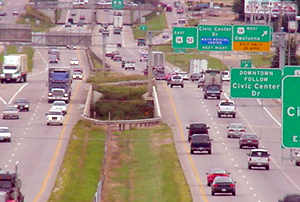 |
Traffic congestion continues to increase in Rochester on the Hwy 52
corridor spurred by the region’s economic and population growth. Photo
by Rollin Larson
|
Rochester/District 6 will install its first surveillance cameras and electronic
message signs on the Hwy 52 corridor in Rochester to monitor conditions and
manage traffic on the increasingly busy highway.
The cameras will alert State Patrol dispatchers and traffic managers about
conditions and enable them to issue warnings or advisory notices to motorists.
The system will also enable managers to clear crashes in the corridor more quickly.
Crashes can cause severe back-ups because of heavy traffic on the roadway.
The installation includes eight cameras and five message signs that will be
located between 55th Street NW to Hwy 63 (South Broadway). The intelligent transportation
system devices will be linked to the State Patrol dispatch center located at
the district headquarters building by a wireless communication system.
During the past year, approximately 150 crashes occurred in on the Hwy 52 corridor
in Rochester, creating serious traffic back-ups.
"The cameras will be used exclusively to monitor traffic conditions so
that incidents such as crashes and stalls can be detected, monitored and cleared
quickly," said Michael Schweyen, project manager.
Installation of the first set of cameras and message signs will provide helpful
information to motorists during the design-build, best-value reconstruction
of Hwy 52 known as ROC 52. Seven additional cameras and message signs will be
added in the corridor on approaches to Hwy 52 as part of ROC 52.
The ITS project also includes the capability to monitor and coordinate timing
traffic signals on major streets in Rochester to better manage local traffic
during and after rebuilding Hwy 52.
The Rochester ITS project is part of a joint effort by Mn/DOT and the State
Patrol to create an integrated network of nine transportation operations communications
centers to serve communities outside the Twin Cities metro area.
Click here to learn more about Mn/DOT’s
ITS programs.
By Brian Jergenson
|
back

|
 |
Renewed effort aims to achieve more diverse workforce |
 |
 |
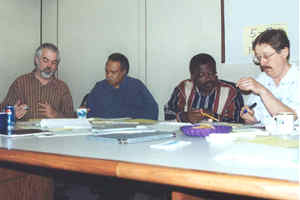 |
At Mn/DOT, the growing presence of people of color, people who have
disabilities, people from diverse economic and geographic backgrounds,
and women add perspective and value to Mn/DOT’s ability to determine,
plan and meet the changing transportation needs of an increasingly diverse
population. Staff photo
|
Mn/DOT launches its new diversity campaign this week, marking the start of
its renewed commitment to integrate diversity into the workplace and standard
business practices.
"Sharing the Journey – A diverse group pursuing a common vision,"
serves as the campaign’s theme because it states the overall goal of the department’s
diversity effort.
"This campaign theme was selected because it basically says we’re all
in this together," said Janet Bouyer, affirmative action officer, Office
of Human Resources. "We all want to be able to work in an environment where
we can feel appreciated and respected. We all want to deliver the best products
and services we can to our customers, and we all want to feel a sense of accomplishment
at the end of the day.
"But what we need to work on is the ‘Sharing the Journey’ part. We have
to achieve these goals together," Bouyer said.
Throughout the month of October, each district, the Metro Division and the
Central Office will hold a diversity activity or event to start the campaign.
Activities will differ. However, the goal of each event is to introduce the
Mn/DOT’s diversity strategic plan, update employees about diversity initiatives,
give employees the opportunity to view the diversity video and provide a forum
for employees to ask questions and make suggestions concerning the department’s
efforts.
"We’d like to see everyone participate in the different activities. This
is an opportune time to gain a better understanding of what diversity really
is and how it affects all employees and our work environment," said Daneeka
Marshall-Oquendo, Office of Communications and Public Relations and diversity
event coordinator.
The campaign expresses Mn/DOT’s response to the 2000 Census data that show
that Mn/DOT’s ratio of diverse employees is considerably lower than in Minnesota’s
general population.
"The department hopes to increase the value of diversity in the workplace
so it can better serve the diverse customers who use its products and services,"
Bouyer said.
The department plans to launch several diversity initiatives during the next
months before the change of administration.
"We want to lay a strong foundation for diversity so when the next administration
comes in, they’ll quickly recognize that it is a department priority,"
said Chief of Staff Margo LaBau. "We want them to build on what’s already
been done, not start over."
Diversity events have been scheduled for Central Office on Thursday, Oct. 3,
and for Detroit Lakes/District 4 on Tuesday, Oct. 8, in Fergus Falls. Other
districts plan to send out notices to their employees announcing their activity
dates.
The diversity site is available at ihub/diversity.
By Daneeka Marshall-Oquendo
|
back

|
 |
Steady progress brings Hiawatha LRT to halfway completion mark |
 |
 |
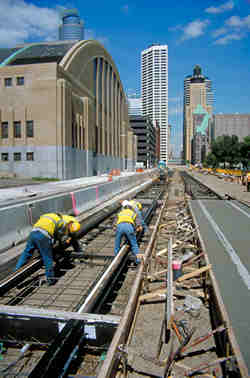 |
Workers install track for the Hiawatha light rail transit line near
the old Minneapolis Armory in downtown Minneapolis. Photo by Josh
Collins
|
As cars, trucks and other vehicles zip through the busy Hiawatha Avenue/Lake
Street intersection, workers remove temporary wood bracing, revealing the bridge
that will carry Hiawatha light rail transit cars over Lake Street and through
the Hiawatha corridor in Minneapolis.
At 38th Street and Hiawatha, patrons at the Cardinal Bar and Grill can watch
progress on the line as roadbed and track installation moves south from downtown
Minneapolis toward the rail line and the station platform under construction
next to the establishment’s parking lot.
Further south, another bridge nears completion. The structure will carry the
trains over Hwy 62, connecting stations at the Minneapolis Veterans Hospital
and at the Bishop Whittle Building at Fort Snelling. A park-and-ride will be
built at Fort Sneering to enable LRT riders to drive part way on their commutes.
In downtown Minneapolis, track installation is complete on six of the nine
blocks the LRT line will use. The remainder will be done by December. Work begins
Monday on 5th Street where it crosses the Nicollet Mall.
Construction at these sites and others during the summer of 2002 moved Minnesota’s
first light rail project to a substantial milestone: the Hiawatha project now
is more than 50 percent complete. Streamlining, combining the traditional construction
design with the building process, has allowed the project’s timeline to be met.
"The project is on time and on budget," said Karen Louise Booth,
acting communications manager, Hiawatha Project Office. Overall completion is
at 55 percent as of Sept. 1.
LRT service will begin on the first section of the 11.6-mile line from the
Warehouse District in downtown Minneapolis to Fort Snelling in the spring of
2004. Service to the Minneapolis-St.Paul airport and the Mall of America in
Bloomington will follow in December 2004.
As of mid-September, embedded track is complete along six of the nine downtown
Minneapolis blocks; by the end of this year, track will be completed on all
nine. The ties and rail are already in place in portions of south Minneapolis.
Rail that was welded and stockpiled alongside the roadway since last fall now
is being connected, section by section, along the 11.6-mile route.
Tunneling nears completion beneath the runways to extend the line to stations
located in the main and charter terminals at the Minneapolis-St. Paul International
Airport. The first tunnel was completed in April; the second tunnel will be
completed this fall.
The power for the light rail cars will come from electrical overhead lines.
The rail cars are 94 feet long and can carry 187 seated and standing passengers.
The light rail cars will be easily accessible, with the rail car’s floor at
the same level as the platform entrance so that access for people who use wheelchairs
or other aids is available at each doorway. Each rail car is equipped with luggage
racks and bicycle storage hangers.
Boothe said not all the work on the Hiawatha happens along the line. At the
project headquarters in the Ceresota Building off Washington Avenue in Minneapolis,
managers, designers, engineers and support staff work purposefully to keep the
project moving toward completion.
Other efforts to bring the LRT system on board include Metro Transit staff
planning coordination of 46 bus routes with the rail system and conducting public
meetings to address questions and concerns about the system, Boothe said.
"Thoughout the fall and winter, our attention is keenly focused on getting
the LRT system operable as Metro Transit heightens its focus on the operations
side of things," she said.
By Josh Collins and Craig Wilkins
|
back

|
 |
Combined Charities drive provides one-stop method for community investment |
 |
 |
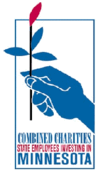 |
The State Employees Combined Charities Campaign runs Sept. 30 through
Oct.11.
|
One dollar doesn’t seem to go very far these days, but sometimes a dollar invested
in the State Employees Combined Charities Campaign can do a lot.
For example, every dollar donated to the campaign can help fund a food bank,
a college education, a drug recovery program, medical research, the arts, health
care or housing.
That’s the message of this year’s two-week campaign, which begins Sept. 30
and runs through Oct.11. Last year, Mn/DOT employees raised about $63,700 from
a relatively small percentage of employees. This year, Mn/DOT’s 2002 campaign
coordinator hopes to raise much more.
"If every state employee gave a dollar a paycheck, we’d raise about $1.5
million," said Ron Bisek, Mn/DOT’s 2002 campaign coordinator, Human Resources.
"That’s only a can of pop every other week. That’s all it takes."
Campaign materials will be circulated soon with information and donation forms.
Employees can also donate—or learn more—at Mn/DOT’s
Web site, the state’s Combined
Charities Web site or by calling 651/297-5675.
Donations are not limited to the member associations of the charity drive.
Bisek said, "Employees can also designate a contribution to any recognized
charity organization, even those that don’t participate in the Combined Charities
drive."
For further information, contact your local coordinator or watch for posters
and events in your work area.
Employees can also find a growing list of office and district coordinators
in the current Employeeline.
|
back

|
 |
New study outlines plans to improve intermodal transportation movement in Winona |
 |
 |
 |
An aerial view shows the Port of Winona and related modal connections,
including rail and truck routes used to bring grain and other commodities
for shipment on the Mississippi River.
|
Mn/DOT recently completed an intermodal study in the city of Winona. The Office
of Freight, Railroads and Waterways, District 6, the city of Winona and the
Edwards and Kelcey consulting firm collaborated to address rail, highway and
waterway transportation issues.
"It's significant because it looks at the modes in a comprehensive manner and
from a long-term perspective," said Judy Bodway, director of Economic Development
for the city and port authority of Winona. According to Bodway, this is the
most comprehensive transportation study Winona has conducted.
"Probably the biggest surprise is some of the recommendations that address
the heavy rail traffic and switching operations we have. Now we have some new
ideas on how to address these issues," Bodway said.
Thirty trains run through the city each day and there are numerous switching
operations in the middle of the city. The Canadian Pacific and Dakota, Minnesota
and Eastern railroads expect that number of trains to more than double in the
next 20 years. The Midwest Regional Rail Initiative could bring an additional
12 high-speed passenger trains running between the Twin Cities and Chicago through
Winona daily.
Currently Winona has 17 railroad crossings at roads and highways. Plans call
for three of these crossings to be separated by bridges or underpasses. The
study recommends that railroad switching operations be transferred away from
the center of the city.
Growing congestion and delays, particular where transportation modes intersect,
have hampered Winona’s future economic development, said Dale Maul, District
6 planner.
Maul says Winona is typical of the growing regional trade centers in his district.
Without additional access controls and intersection improvements on Hwy 61 and
Hwy 43, significant congestion may reduce travel speeds by as much as 75 percent.
According to Maul, this in turn would negatively impact the port authority’s
plan to grow.
"The modes are interdependent and must work well together to provide a coordinated
transportation system," he said.
Study recommendations include investment strategies for rail, highway and port
enhancements estimated at $34.5 million. The Winona City Council accepted the
report's recommended investment strategies and had already begun access and
other improvements at the intersection of Hwy 14 and Hwy 61. The work represents
one of the first steps the city is taking to facilitate traffic flow and improve
access to the harbor and downtown Winona.
"Now we have a more comprehensive approach to transportation planning," says
Bodway. "This will enhance the quality of life for Winona residents as well
as those who pass through our city."
For more information, see http://www.dot.state.mn.us/ofrw/winonastudy.html.
By Brian Jergenson and Sue Stein
|
back

|
 |
Duluth Airport joins the state’s new Adopt-An-Airport program |
 |
 |
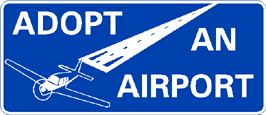 |
The Duluth Airport, Minnesota’s second largest airport, is the second
airport in Minnesota to join the Adopt-An-Airport program.
|
The Duluth Airport, Minnesota’s second largest airport, became the second in
Minnesota to join the Adopt-An-Airport program. The Cook Airport was the first
airport to enroll and begin volunteer participation in the program.
Adopt-An-Airport is a volunteer program open to civic clubs, chambers of commerce,
business and professional organizations, community groups and individuals. The
groups work with airport management to decide how to best help support, maintain
or beautify the airport.
"The Adopt-An-Airport program is great for the community and the airport,"
said Ray Rought, director of the Office of Aeronautics, at the Commemorative
Air Force display at the Duluth Airport on Aug. 31. "The airport is the
front door to the community and Duluth is on the leading edge of high-tech aviation."
The first project at the Duluth Airport will include planting shrubs and perennial
plants to enhance the airport's entrance. Participants from the four registered
volunteer groups—Abby Travel Inc., Helping Hands of Youth, Commemorative Air
Force and Lake Superior College Flight Students—will begin work this fall.
The partnership benefits the airport, the city and the volunteers. Volunteers
learn about their local airport and its influence on the community. Airports
get the benefit of volunteer help to work on improvement projects. The combined
effort of the volunteers and the airport management and staff help to enhance
the understanding and value of the airport throughout the community.
"We think this is a great opportunity for our students to volunteer their
time and expertise to help the airport grow and thrive. It is also a great way
to educate our youth about aviation and aviation careers," said Julias
Salinas, director of the Lake Superior College aviation program.
For more information, contact Janese Thatcher-Buzzell, Office of Aeronautics
at 651/297-7652.
By Sue Stein
|
back

|
 |
Star Tribune praises Tinklenberg for his clarity, courage |
 |
 |
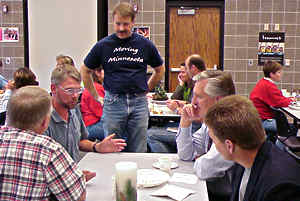 |
Commissioner Elwyn Tinklenberg and Tim Worke, director of Government
Relations (at right) listen with Wes Gjovik, district engineer at Bemidji
(left) and Miles Ruland, heavy equipment mechanic (standing) as Duane
Hill, district bridge engineer, tells a story about living (and fishing)
in the North Woods. Employees at the Bemidji District headquarters turned
a thank-you visit by Tinklenberg Sept. 25 into a thank-you for him for
his advocacy of transportation. Tinklenberg received farewell gifts
including a black and red "Paul Bunyan" style shirt, wild rice and maple
syrup from district employees. Photo by Trish Ritchie
|
Commissioner Elwyn Tinklenberg’s recent announcement that he will leave Mn/DOT
on Oct. 4 sparked a positive editorial in the Sept. 22 Star Tribune,
which praised him for telling Minnesotans "not necessarily what they wanted
to hear but what they needed to hear. His frequent explanations helped
lift the interwoven issues of roads, transit, housing and development to the
top of the state's agenda."
Noting "his clarity and courage on these matters," the editorial
added that Tinklenberg "deserves the gratitude of Minnesotans. The preponderance
of research and professional opinion nationwide bolster his views."
Click here to read more of the Star
Tribune editorial. To read other transportation-related news stories,
visit Mn/DOT’s online
news clipping site.
|
back

|
 |
|
 |



